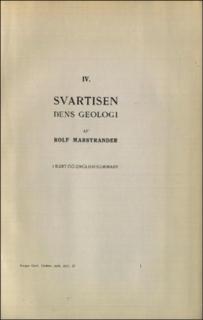IV. Svartisen. Dens geologi
| dc.contributor.author | Marstrander, Rolf | |
| dc.coverage.spatial | 20274 Storforshei | |
| dc.coverage.spatial | 20283 Blakkådal | |
| dc.coverage.spatial | 19274 Sjona | |
| dc.coverage.spatial | 19271 Mo i Rana | |
| dc.coverage.spatial | RANA | |
| dc.coverage.spatial | 19282 Svartisen | |
| dc.coverage.spatial | RØDØY | |
| dc.coverage.spatial | MELØY | |
| dc.coverage.spatial | 19283 Melfjorden | |
| dc.date.accessioned | 2020-08-26T13:29:01Z | |
| dc.date.available | 2020-08-26T13:29:01Z | |
| dc.date.issued | 1911 | |
| dc.identifier.uri | https://hdl.handle.net/11250/2675198 | |
| dc.description.abstract | Forkortet: The glacier Svartisen is, next to Jostedals glacier, the largest in Norway, and one of the largest in Europe. The arctic Circle passes through its southern part. Wherever accessible, the underlying rocks are found to consist mainly of granite in the Western Plateau, or crystalline schists in the Eastern, to be traced to the so-called mica-schists-marble group, (probably of cambro- silurian age) to which the greater part of the crystalline schists in Nordland belongs. The crystalline schists must rather be described as a series of gneiss and mica-schists, containing all posssible variations of these two rocks,besid- es quartzites and bands of amphibolite. Specially prominent was the garnet- mica-schist; it was characteristic of the whole district. | |
| dc.language.iso | nor | |
| dc.relation.ispartofseries | NGU (59) | |
| dc.rights | Navngivelse 4.0 Internasjonal | |
| dc.rights.uri | http://creativecommons.org/licenses/by/4.0/deed.no | |
| dc.subject | OMDANNET BERGART | |
| dc.subject | PETROGRAFI | |
| dc.subject | GRANITT | |
| dc.subject | KARTLEGGING | |
| dc.subject | STØRKNINGSBERGART | |
| dc.subject | SEDIMENTÆR BERGART | |
| dc.title | IV. Svartisen. Dens geologi | |
| dc.type | Journal article | |
| dc.description.localcode | 35920 | |
| dc.source.pagenumber | 31 |
Files in this item
This item appears in the following Collection(s)
-
Artikler [1064]
Artikler fra seriene NGU, NGU Bulletin og NGU Skrifter

